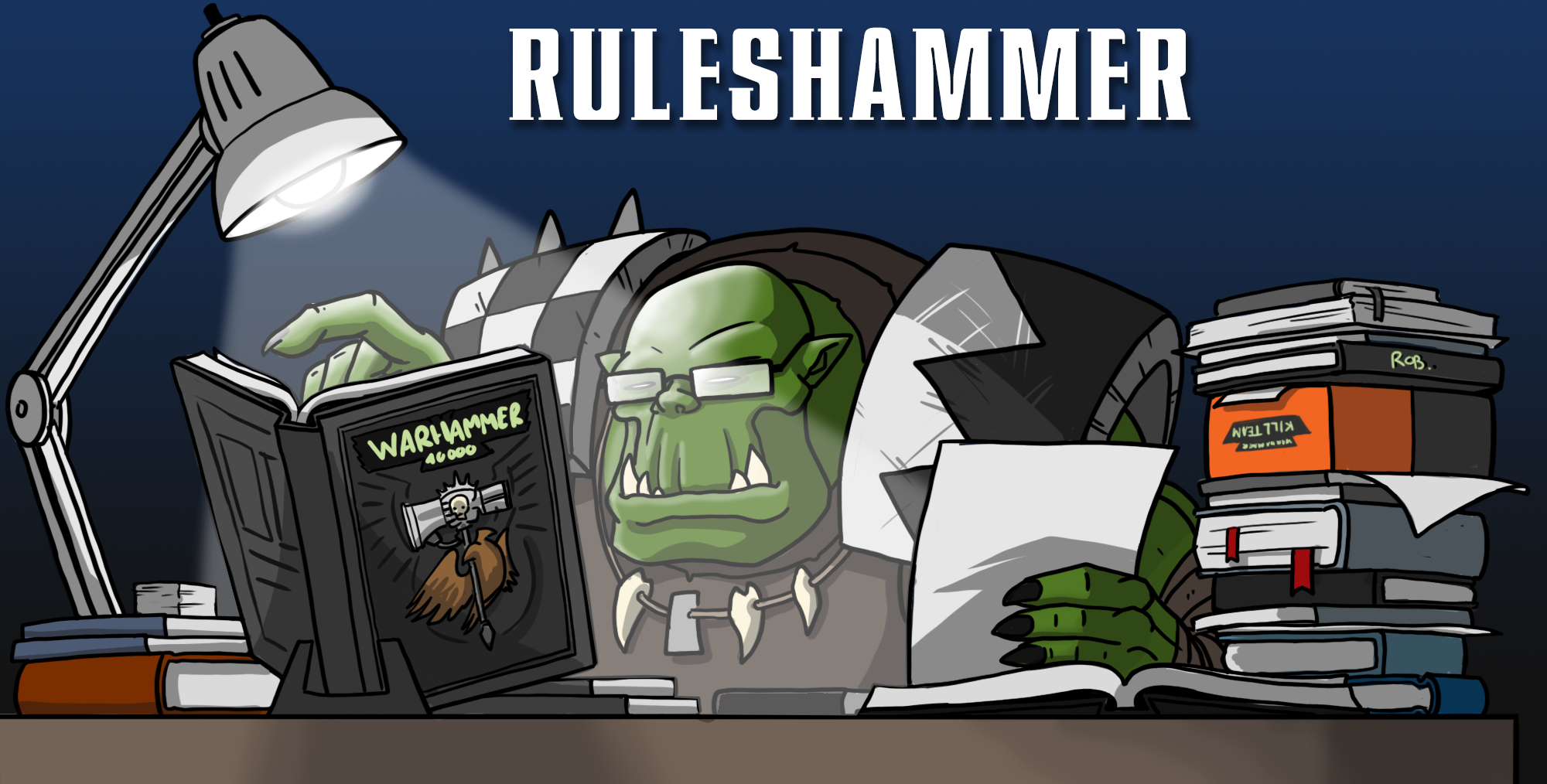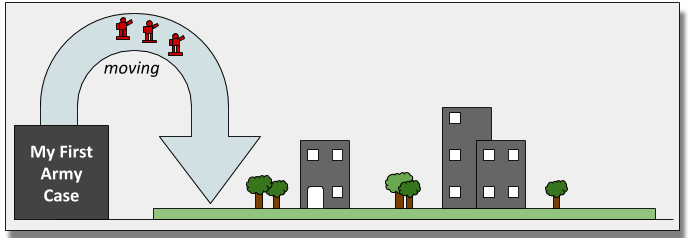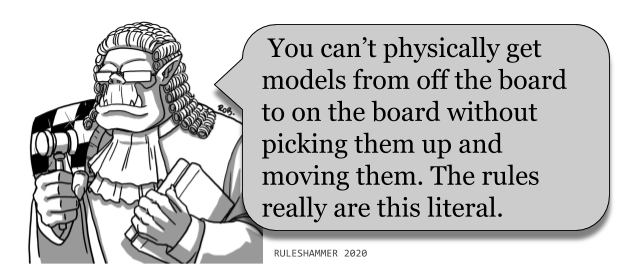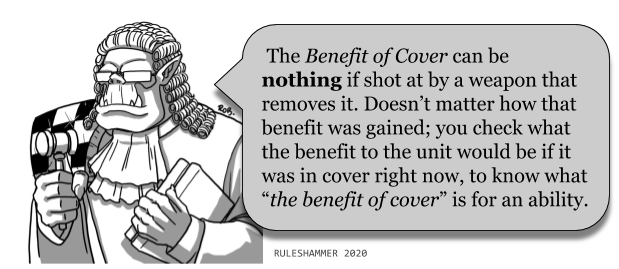Although we love Warhammer 40,000, the game’s complexity can be daunting, particularly for newer players. In Ruleshammer, we look at the nuances of the game’s rules and how they affect gameplay, clearing up potential issues and helping make sense of some of the game’s less common interactions. In today’s Ruleshammer, Rob “Vre’kais” Chilton covers some of your questions!
Your Questions Answered!Ruleshammer: Mailbag 004
Question from Chuck regarding: Hiding near a Wave Serpent.
Given that models measure from the base except for certain models such as vehicles that don’t have bases and instead measure from the hull, how does the measurement to the vehicle interact with “closest” model behaviors? For example: say you have an Eldar Farseer that is standing in front of a Wave Serpent (in that space between the “wings” of the Wave Serpent). Technically the Wave Serpent hull extends around all sides of the Farseer. Does that mean the Farseer is never targetable from any direction while the Wave Serpent is alive? Have I explained this well enough to be comprehensible?
Yes. The Wave Serpent can prevent shooting from most sides if you hide a model in the gap. There’s a few other vehicles that can do this to lesser or greater extent, the Forge World Sicaran Battle Tanks have a very Lieutenant sized gap in the front between their tracks for instance. Corrode: This is a helpful trick that both Wings and I have used in the past, though don’t forget that most things that are going to shoot at a character hiding in the Wave Serpent gap ignore the character targeting restriction anyway, such as Eliminators.
Question from Dave McIrish regarding: Applying variable damage to a target.
How does wound allocation work with models that cause variable damage? Who chooses which damage is allocated?
For example, if a Broodlord is in combat with a unit that has models all with 3 wounds each. Let’s say the Broodlord causes 4 wounds, one of them is a 6 which causes a flat 3 damage, and all saves are failed.
The rest of the wounds are D3 and cause one wound each. So flat 3 damage plus 3 single damage.
If the flat 3 is applied first, it kills one model and then the next 3 single wounds carry over and kill another model.
The defending player however might choose to apply one wound, then another, THEN the flat 3 (which kills the model but causes 2 damage to be lost) and apply the final 1 damage onto the next model, leaving them with an extra surviving model with 2 wounds, rather than two slain models.
To do this correctly you have to slow it down, fast rolling has some conditions in the rules before it should be used.
In order to make several attacks at once, all of the attacks must have the same Ballistic Skill (if it’s a shooting attack) or the same Weapon Skill (if it’s a close combat attack). They must also have the same Strength, Armour Penetration and Damage characteristics, and they must be directed at the same unit. [Core Rules Pg5]
Generally with variable damage weapons most players will fast roll the hits and the wounds as that doesn’t usually make a difference. Then if say using a D3 Damage weapon against 2 Wound models, you’d roll for the damage one at a time. The order matters here because the rules for attacks are written with them happening one at a time. If they manage to get 4 successful wounds and roll 1,2,1,3 on their dice that would kill just 2 models. If they rolled 1,1,2,3 then that would be 3 kills.
The Broodlord is a special case here because the to wound roll itself can affect the damage. So in situations where it’s facing a unit of models with 2 or more wounds each you’d have to slow roll each attack from the wound roll onwards. If it was facing a single model though, or a unit of models with only 1 wound each then you can fast roll the whole sequence because the variable damage is either all applied to that single model or doesn’t make a difference.
I’ve gone over slow rolling in more detail in this article.
Question from Dave Baer regarding: What counts as moved.
I was poring over rules and discovered a very strange interaction with the Tau Dal’Yth Sept trait. The new wording states that units “gain the advantage of cover even when in the open” and “lose this trait until their next movement phase if they move for any reason”
Therefore, arriving via Manta Strike, Low Altitude Drop, or disembarking from a Transport should not remove this trait and the unit should count as being in cover the moment it arrives. These rules state that the units “count as having moved for all rules purposes” but the actual act is Setting Up rather than moving. In my eyes, you can never point to a specific point where the unit DOES MOVE or takes an act that COUNTS AS MOVING, therefore the trait’s rule never triggers and cover is never removed. However the people I talk to point to the phrase “counts as having moved for all rules purposes” and say that Dal’Yth Sept’s trait is a “rule”. It’s very messy.
I noticed in your post about transports, you had a judge ruling that specifically addressed the way that disembarking counts as a Set Up rather than a true move, which would seem to support my finding. What do you think?
This isn’t that messy at all; here’s the moment when the models moved. Caught recently on camera by our team in the field who waited for several months to catch this rare sight.
Of course this only applies to models arriving/disembarking mid game. Deployment doesn’t count as moving as it’s done before the first battleround.
To clarify this Judge Ruleshammer ruling though;
This is to do with how the models get from the transport to their new location. Which is not a move from transport to destination, they are set up on the board at any valid position. This avoids the rules against moving within 1” and moving through enemy models. They do however still 100% count as moved, as do all models that started off the board during a turn.
Question from Boaty Still regarding: Benefit of Cover and Ignore Cover abilities.
‘I’m writing with a question about the wording of cover benefits in the current rules set of Warhammer 40,000. Is there a difference between being ‘in cover’, and receiving ‘the benefit of cover’? And is there a difference between ignoring the benefit of being ‘in cover’, and the benefit ‘of cover’?
Boaty also gave a few examples of where this gets confusing regarding Prepared Positions, Tau Smart Missiles, the Imperial Fists Chapter Tactic, and the Raven Guard Chapter Tactic. Lets go over each one.
Prepared Positions
Prepared Positions Use this Stratagem at the start of the first battle round, before the first turn begins. Until the end of the first turn, all units from your army – other than TITANIC units, AIRCRAFT units and units with the Fortification or Flyer Battlefield Roles – that are wholly within your deployment zone receive the benefit of cover, even while they are not entirely on or in a terrain feature. A unit that is already receiving the benefit of cover gains no additional benefit from this Stratagem.
So this strat is fairly straightforward; it gives units the “benefit of cover” for the first turn whilst wholly within your deployment zone, which will be everything except any models that infiltrated or that weren’t deployed on the board for turn one. What is the Benefit of Cover though? This isn’t explained with the rest of the terrain rules on page 106 of Chapter Approved 2019, that just explains what units need to do to get it. It’s in the core rules though! In a tiny little box on page 181 in the Big Rule Book or page 7 of the Core rules PDF.
Terrain and Cover The battlefields of the far future are littered with terrain features such as ruins, craters and twisted copses. Models can take shelter within such terrain features to gain protection against incoming weapons’ fire. If a unit is entirely on or within any terrain feature, add 1 to its models’ saving throws against shooting attacks to represent the cover received from the terrain (invulnerable saves are unaffected). Units gain no benefit from cover in the Fight phase (pg 182).
So the “benefit of cover” is the +1 to saving throws. What next?
Tau Smart Missiles
Smart Missiles: This weapon can be fired at units that are not visible to the bearer. Units attacked by this weapon do not gain any bonus to their saving throws for being in cover.
I think this rule is a few wording updates behind but I don’t think that’s a reason to treat it any differently. There’s an argument that this weapon only removes the bonus to saving throws if the units are in cover, rather than units not actually in cover but receiving the benefit of cover. However I disagree with that reasoning, here’s why; Smart Missiles change what the benefit of cover is, in this case to nothing, no bonus to the saving throw. Abilities like prepared positions allow a unit to receive the “benefit of cover” as if they were in cover. If the target of a Smart Missiles attack was in actual cover they wouldn’t get the bonus, so you do the same for Prepared Positions.
Imperial Fists Chapter Tactic
When resolving an attack made with a ranged weapon by a model with this tactic, the target does not receive the benefit of cover to its saving throw and, if that attack was made with a bolt weapon (pg 166), an unmodified hit roll of 6 scores 1 additional hit.
This is newer clearer wording for ignore cover abilities but the net result is exactly the same as the Smart Missiles, no benefit of cover when shot by a unit with this tactic.
Raven Guard Chapter Tactic
When resolving an attack made with a ranged weapon against a unit with this tactic by a model that is more than 12″ away, that unit is treated as having the benefit of cover to its saving throw, and if that unit is not a VEHICLE and is entirely on or within a terrain feature, subtract 1 from the hit roll.
This chapter tactic allows units to have the benefit of cover whenever shot at from more than 12” away, fairly simple. IF they’re also on a terrain piece and still 12” away they also have -1 to hit. What is sometimes conflated though is that the -1 to hit is not a benefit of cover, it’s for being “entirely on or within a terrain feature” and “shot at from more than 12” away”, so half of the conditions for it are the same as cover but it’s entirely independent.So what happens when this unit is shot at by an ignores cover weapon? They just lose the bonus to saving throws, the -1 to hit remains as it is and is unaffected.
Death Watch Dragonfire Bolts
Add 1 to the hit rolls for this weapon when targeting a unit that is in cover.
This was actually surprisingly clear even before it was FAQed;
Q: How do Dragonfire bolts behave when shooting units that aren’t in cover, but have a rule that means they have ‘the benefit of cover’ (e.g. Jormungandr units with the Tunnel Networks ability)? Would you still add 1 to the hit rolls for Dragonfire bolts?
A: No. You add 1 to the hit rolls against units that are in cover (i.e. entirely on or within a terrain feature). Units receiving the benefit of cover while not being in cover do not count.
Definitely unambiguous now so Dragonfire would have no effect on units using Prepared Positions or the Raven Guard Chapter Tactic unless the units being shot on were also physically within cover as described by the Terrain and Cover rules.
As ever If you want your rules debate answered you can submit questions both on reddit, or via this form. Or drop us a note in the comments below or email us at contact@goonhammer.com.






